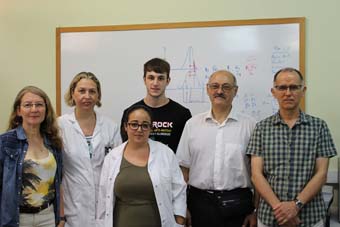
Researchers of the IFIC (mixed centre of the Universitat de València and CSIC) take part in a European project to develop a new system that is capable of real-time measuring the tritium concentration in the nuclear power plant’s water. Controlling the abundance of this element in real time will allow to develop an early warning system in case of anomalies at the plant as well as to monitor the suitability of the tritium levels in the water for human consumption.
The experts, who work in the Scientific Park of the Universitat de València, use the experience of IFIC in the development of particle detectors, such as the ones used by NEXT, which is an experiment to build a device that control the tritium levels in the water that comes from the refrigeration of the nuclear reactor, within which great amounts of this radioactive isotope are produced. Controlling the abundance of this element in real time will allow to develop an early warning system in case of anomalies at the plant as well as to monitor the suitability of the tritium levels in the water for human consumption.
The project is called TRITIUM and it has been funded with 1’5 million euro in the last call of the Interreg SUDOE 2016 programme in which there were more the 500 proposals. It is coordinated by the Universidad de Extremadura, which will use the samples of the Almaraz plant (Cáceres) and it counts on the participation of other research centres of Portugal and France. In the IFIC, the coordinator of the project is José Díaz. He is full university professor at the Universitat de València (UV) and one of those responsible for the Environmental Radioactivity Laboratory of the UV.
‘Tritium is one of the radioactive elements produced in great abundance in the nuclear power plants’, explains Díaz. ‘Despite the low level of radioactive dose that it produces, since it only emits beta radiation of a lower energy, its concentration in water can denote an operational problem because it is one of the main products generated in a nuclear reactor’. The measuring of the tritium concentration in water is only one of the parameters used to control the radioactivity levels of a nuclear power plant, together with the alpha, beta and gamma radiation.
The goal of the project, which will last four years, is to develop a prototype of a system that measures in real time the tritium levels in the water that comes from the refrigeration of the nuclear reactor. Nowadays it is possible to determine the tritium activity in two days by using water samples that are measured in a laboratory placed out of the nuclear power plant. The new system developed by TRITIUM will be placed in the refrigeration dam of the plant and it will be capable of measuring the tritium levels every ten minutes.
In order to do so, it will use technology developed for particle physics experiments such as Silicon photomultiplier (SiPM) and the scintillator fibre. When the tritium disintegrates, it produces an electron that emits energy in the shape of beta radiation. This electron collides scintillator fibres and produces light. This signal becomes electric current due to the silicon photomultipliers and it is amplified and registered by a lecture system to measure the tritium amount present in the water sample.
The IFIC group that takes part in TRITIUM has a wide experience in the development of these technologies. It uses the silicon photomultipliers in the NEXT experiment, which is an international collaboration led by the IFIC researcher Juan José Gómez Cadenas and whose goal is to prove if neutrino is its own antiparticle. On the other hand, the scintillator fibre system was used in the construction of one of the detectors installed in the GSI nuclear physics laboratory placed in Darmstadt (Germany).
According to José Díaz, the new system will be able to reach the sensitivity of 100 Becquerel per litre. This measure guarantees the water’s potability (the nuclear power plants are refrigerated with waters that are subsequently used in drinking water and irrigation). It will take advantage of the Environmental Radioactivity Laboratory of the UV experience since it makes this kind of analysis on demand as well as the experience of the Universidad de Extremadura that is led by Antonio Baeza and works with the Almaraz plant. This entity will develop a system to achieve ultrapure water for the samples.
The IFIC works to create the detector to measure the tritium levels together with the Universidade de Aveiro (Portugal). The group of the Centre d'Etudes Nucléaires de Bordeaux-Gradignan (CENBG, CNRS-University of Bordeaux, France) works on the detector’s shielding as well as to minimize the noise and the device’s simulations. The researchers hope to have a prototype in 2020 in order to prove it in nuclear power plants and to register a patent.
Last update: 13 de september de 2017 11:45.
News release



















